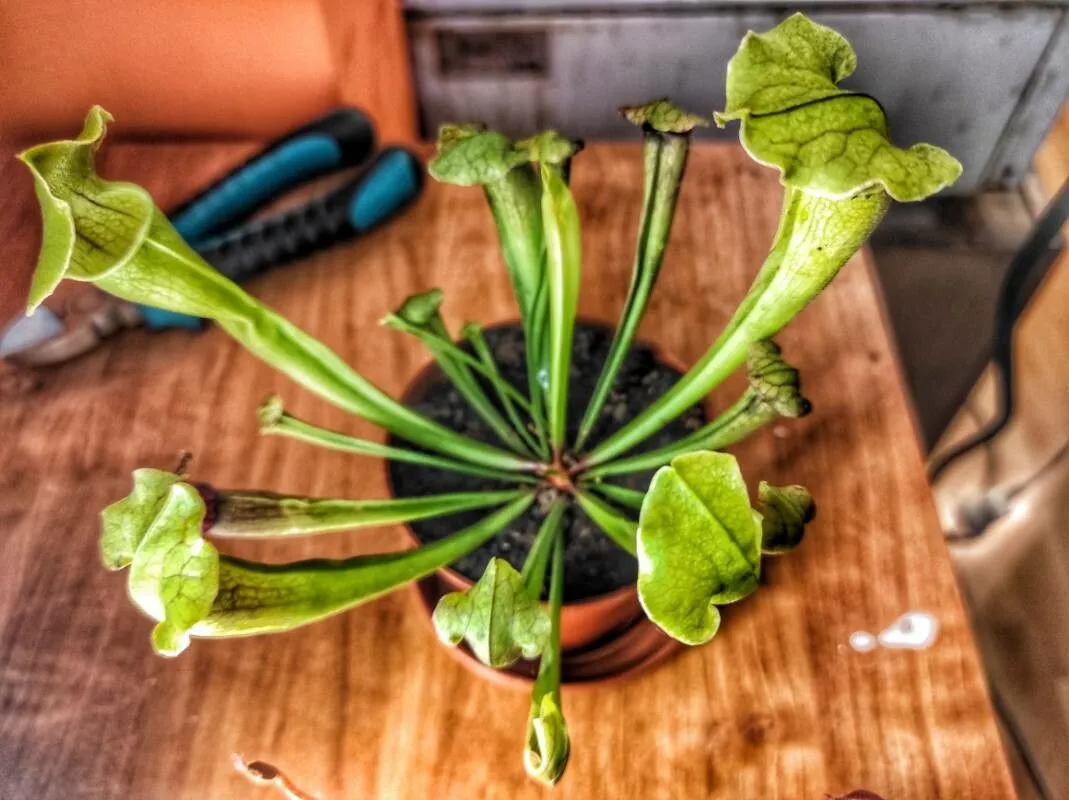
Author: L.
Bibliography: Sp. Pl.: 510 (1753)
Year: 1753
Status: accepted
Rank: species
Genus: Sarracenia
Vegetable: False
Observations: SE. U.S.A.
The Yellow Pitcherplant, scientifically named Sarracenia flava, is a captivating carnivorous plant native to the southeastern United States. This extraordinary species belongs to the Sarraceniaceae family, a group renowned for their unique adaptations designed to lure, capture, and digest insects.
Discovered and documented by the eminent botanist Carl Linnaeus in “Species Plantarum” back in 1753, Sarracenia flava has since fascinated botanists and plant enthusiasts alike. It primarily thrives in boggy and swampy habitats where nutrient-poor conditions compel it to derive essential nutrients through an ingenious predatory mechanism.
The plant’s distinctive feature is its tall, trumpet-shaped pitchers which can grow up to 80 cm in height. These vibrant yellow-green pitchers are not just visually striking but also cleverly engineered. They possess a combination of colors, nectar, and scent to attract unsuspecting insects. Once an insect lands on the lip of the pitcher, it often loses its footing on the slippery surface, tumbling down into the deep cavity below.
The interior walls of the pitcher are lined with downward-facing hairs that prevent the trapped prey from escaping. At the bottom of the pitcher, a pool of digestive enzymes and bacteria breaks down the insect, allowing the plant to absorb the necessary nutrients, primarily nitrogen and phosphorus, which are scarce in its natural soil environment.
In addition to its biological significance, the Yellow Pitcherplant plays an important role in its ecosystem. It helps control insect populations and provides habitat for specific species of spiders and other insects that live symbiotically with the plant.
Conservation efforts are crucial for Sarracenia flava, as its natural habitats face threats from human activities such as land development, drainage of wetlands, and pollution. Cultivation and propagation in botanical gardens and nurseries also serve as measures to ensure the survival of this remarkable species.
A symbol of botanical ingenuity, the Yellow Pitcherplant not only highlights the incredible diversity of plant life but also underscores the intricate interactions within ecosystems that sustain our natural world.
Deu: gelbe schlauchpflanze
Swe: gul flugtrumpet
Eng: trumpetleaf, trumpets, umbrella-trumpets, yellow pitcherplant
En: Yellow pitcherplant, Trumpetleaf, Trumpets, Umbrella-trumpets, Yellow pitcher plant, Pitcher-plant Yellow
Ar: عشبة الأباريق البوقية الصفراء
Zh: 黄瓶子草
Nl: Gele trompetbekerplant
De: Gelbe Schlauchpflanze
Hu: Sárga kürtvirág
Sv: Gul flugtrumpet
Taken Dec 14, 2020 by Susi Alessio (cc-by-sa)
Taken Mar 6, 2022 by Tristan Jaton-Maria (cc-by-sa)
Taken Mar 6, 2022 by Tristan Jaton-Maria (cc-by-sa)
Taken Apr 9, 2022 by Annemarie Ahrens-Stehle (cc-by-sa)
Taken Jul 20, 2017 by chriselis (cc-by-sa)
Taken Jun 29, 2020 by essedì (cc-by-sa)
Taken May 15, 2021 by Denis Alkan (cc-by-sa)
Taken Jul 15, 2013 by Photoflora – Benoit BOCK (©)
Taken Mar 6, 2022 by Tristan Jaton-Maria (cc-by-sa)
Taken May 23, 2022 by torsten gerhold (cc-by-sa)
Taken Mar 20, 2021 by Aymeric sperandio (cc-by-sa)
Taken Apr 9, 2022 by Annemarie Ahrens-Stehle (cc-by-sa)
Taken Feb 20, 2019 by Laura Chatterton (cc-by-sa)
Taken Mar 12, 2016 by Tela Botanica − Jean-Claude ECHARDOUR (cc-by-sa)
Taken Jun 15, 2010 by EOL − Barry Rice (cc-by-nc-sa)
Taken Jun 15, 2010 by EOL − Barry Rice (cc-by-nc-sa)
Taken Jun 15, 2010 by EOL − Barry Rice (cc-by-nc-sa)
Taken Aug 12, 2022 by manuseitz (cc-by-sa)
Taken Feb 4, 2022 by Waldemar Zeja (cc-by-sa)
Taken Jun 15, 2009 by EOL − Barry Rice (cc-by-nc-sa)
Taken Jul 20, 2022 by Catherine Ezo’o (cc-by-sa)
Taken Jul 15, 2013 by Photoflora – Benoit BOCK (©)
Taken Jun 15, 2009 by EOL − Barry Rice (cc-by-nc-sa)
Taken Sep 15, 2020 by claude sarrat (cc-by-sa)
© copyright of the Board of Trustees of the Royal Botanic Gardens, Kew.
© copyright of the Board of Trustees of the Royal Botanic Gardens, Kew.
© copyright of the Board of Trustees of the Royal Botanic Gardens, Kew.
Growth habit>: Forb/herb
Family: Myrtaceae Author: (F.Muell.) K.D.Hill & L.A.S.Johnson Bibliography: Telopea 6: 402 (1995) Year: 1995 Status:…
Family: Rubiaceae Author: Pierre ex A.Froehner Bibliography: Notizbl. Bot. Gart. Berlin-Dahlem 1: 237 (1897) Year:…
Family: Sapindaceae Author: Koidz. Bibliography: J. Coll. Sci. Imp. Univ. Tokyo 32(1): 38 (1911) Year:…
Family: Asteraceae Author: A.Gray Bibliography: Pacif. Railr. Rep.: 107 (1857) Year: 1857 Status: accepted Rank:…
Family: Fabaceae Author: Medik. Bibliography: Vorles. Churpfälz. Phys.-Ökon. Ges. 2: 398 (1787) Year: 1787 Status:…
Family: Aspleniaceae Author: (Cav.) Alston Bibliography: Bull. Misc. Inform. Kew 1932: 309 (1932) Year: 1932…